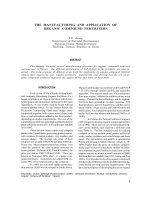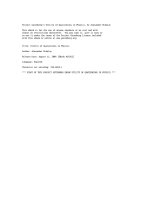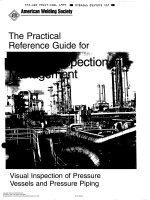Inspection of Vertical Transportation Equipment_11 pot
Bạn đang xem bản rút gọn của tài liệu. Xem và tải ngay bản đầy đủ của tài liệu tại đây (14.53 MB, 27 trang )
16-2
Simpo PDF Merge and Split Unregistered Version -
16-3
Simpo PDF Merge and Split Unregistered Version -
16-4
Simpo PDF Merge and Split Unregistered Version -
16-5
Simpo PDF Merge and Split Unregistered Version -
16.1.4 Applicable Safety Standards
There is no safety standard written specifically for this type of equipment. Section 5
GENERAL SAFETY STANDARDS ANSI/ASME B20.1 Safety Standards for Conveyors and
Related Equipment and ANSI A10.5 Safety Requirements for Material Hoists could be used for
guidance.
16.1.5 Inspection Interval
The inspection interval should be determined by the application of the equipment and the
environment in which it works. It is recommended that these devices be inspected every month
but not less than bimonthly.
16.2 INSPECTION MADE FROM INSIDE CAB
16.2.1 General Safety Precautions
Visually inspect the crane's runway and adjacent storage racks for personnel and/or objects in
the aisle or protruding from the storage bins. Determine that all loose items such as tools or
materials are removed from the carriage before attempting operation. Inspect the crane's controls
for any markings or other methods indicating that the crane is not to be operated. Such markings
may mean that the crane is inoperative or in the process of being repaired. Place a sign on the
disconnect switch stating that the crane is being inspected. Determine that all the guards are in
place.
16.2.2 Enclosure
Determine that the cab enclosure is structurally sound and securely fastened. Examine
lighting fixtures to determine whether they are securely fastened and have required protection.
Determine that sufficient illumination is provided. Determine that a fire extinguisher is properly
mounted and available. Open the cab gate and determine that the cab will not move with gate
open. Determine that a seat belt is provided for the cab operator. Determine that a lifeline is
provided for the cab operator if evacuation is necessary, from the crane, when in an elevated
position.
16.2.3 Operation
Check controls for proper identification. (See Figure 16-5). Depress the stop switch and note
whether the crane will operate. Movement of the joystick should not move the crane unless both
foot switches and the hand
16-6
Simpo PDF Merge and Split Unregistered Version -
16-7
Simpo PDF Merge and Split Unregistered Version -
operated safety interlock control are in the operating positions. With the crane running, release
any, either or both of the foot switches or the safety interlock. All crane motions should stop. It
will be necessary to release both foot switches as well as the safety interlock and the joystick
master before motion can be resumed. With the foot switches and the safety interlock in
operating position, place the joystick control in the full or hoisting direction. The platform
should decelerate from full speed to slow speed and automatically stop at the upper limit.
Reverse the direction and check the lower limit. With the foot switches and the safety interlock
in operating position, place the joystick control in full forward position. The crane should
decelerate and stop at the end of the aisle. Reverse the direction and check the reverse aisle limit
switch.
16.3 INSPECTION OF THE BRIDGE
16.3.1 General
The bridge is that part of the crane consisting of the lower truck, hoist drive system, hoist
drum, and aisle drive.
16.3.2 Guides
Determine that the floor mounted guide rail is free of debris. Check all lower guide rollers for
worn or damaged wheels, bearings or shaft pins. (See Figure 16-6). Inspect the wheels for
cracks or chipping. Inspect the wheels for flat spots and any unusual wear patterns or markings.
Check the wheel bearings for adequate lubrication. Inspect the wheels for excessive float.
Wheel float is the amount the wheel can move across the rail. The allowable wheel float is
approximately 1/8 inch. If any of these conditions exist, the wheels must be repaired or replaced.
16.3.3 Hoist Drive System
Check the brake linings for wear, and the air gap for proper spacing. Check the mounting
bolts to insure they are tight. Check the hoist drive system (See Figure 16-7). The hoist drive
system consists of a motor, gear case, holding brake, load brake and hoist drum. The hoist drive
system serves to raise and lower the carriage by wire ropes. Hoisting power is provided by an
AC wound rotor type motor driving the rope drum through a reduction gear box. A magnetorque
load brake is employed to help control the speed of the hoist motor. A spring-set shoe type
motor brake is used to stop the motor. This motor brake holds the hoist system in position until
power is reapplied. Check the motor bearings for proper lubrication and vibration due to wear.
Check motor brushes for adjustment or replacement and the slip ring for reconditioning. Check
the gear case for proper oil level, using the visual oil level indicator.
16-8
Simpo PDF Merge and Split Unregistered Version -
16-9
Simpo PDF Merge and Split Unregistered Version -
16-10
Simpo PDF Merge and Split Unregistered Version -
The oil level should not exceed the level indicator. If the gear case is overfilled it will not retain
the excessive oil and will leak onto other components. (See Figure 16-8). Check the gear for
excessive backlash and possible excessive shaft end play.
16.3.4 Hoist Drum
The hoist drum is a machined circular casting mounted on the side of the gear case. The drum
is used to take up and let out the wire ropes that raise and lower the crane carriage. The hoist
drum should be examined and tested with light blows from a hammer. If the resulting sound
from the blows is dull and flat unlike the ring given by sound metal, the hoist drum should be
examined carefully for cracks. The hoist drums are irreparable items. If the drums have any
clicks, new drums must be installed.
16.3.5 Wire Rope or Cable
16.3.5.1 General. All wire rope will eventually deteriorate to a point where it is no longer
serviceable. There are three basic causes of wire rope deterioration. They are:
a. Abrasion or wear
b. Corrosion
c. Fatigue, caused by the pulling, bending, crushing or kinking forces applied to the rope
during normal services.
None of the above causes of deterioration can be eliminated entirely. However, all three can be
minimized, thus insuring the longest possible safe service life from the rope.
16.3.5.2 Inspection. The first step toward the proper care of wire rope is an inspection schedule.
All wire rope used for lifting of loads should be inspected on a periodic basis, preferably at least
weekly. This inspection should be aimed at determining the degree of deterioration at the worst
rope lay since this will determine the suitability for continuous service. By definition, a rope lay
is the axial distance along the rope in which one strand makes one complete turn around the rope.
The inspector should pay particular attention to the following:
a. Internal wear caused by grit penetrating between the strand and wires.
b. Kinking.
c. Lubrication.
d. Corrosion.
16-11
Simpo PDF Merge and Split Unregistered Version -
16-12
Simpo PDF Merge and Split Unregistered Version -
e. Number of broken strands per lay.
f. The manner in which the fittings are attached.
g. The condition of the sheaves over which the rope must pass, including sheave alignment.
h. The amount of wear on the outer wires.
Any evidence of serious rope deterioration from corrosion should cause consideration to be given
to immediate replacement of the rope. More than one strand should be cause for caution. Breaks
occurring in the valley between adjacent strands are generally a warning of an abnormal
condition, justifying caution. Any broken wires at the dead end of a cable should be cause for
cutting off a section. Preferably at least three feet beyond the broken wires. Refasten the rope.
If the rope is not long enough, use a new piece of rope. Any of the following conditions should
cause the inspector to question the remaining strength of a rope, and to give consideration to the
possibility of discarding the rope:
a. If the core shows through more than one pair of strands.
b. If kinking damage is severe.
c. If there is evidence of improper lubrication, combined with other defects.
d. If wire has come in contact with an electrical circuit or has been subjected to overheating.
e. If there is serious reduction in rope diameter.
f. If there is evidence of "bird-caging". This increased diameter is usually caused by the
sudden releasing of a heavy load while the rope is twisted.
g. If there are numerous broken wires or as many as three adjacent broken wires in one rope
lay.
16.3.6 Inspection Of The Broken Rope Safety Device
(See Figure 16-9). The function of the broken rope safety device is to prevent the carriage
from free-falling in the event of a broken (or slack) hoist cable. Sliding wedges are used to
"Jam" the carriage against the mast to prevent it from free-falling. one complete installation is
found on each side of the carriage. Actuation of the slack cable limit switch occurs in
16-13
Simpo PDF Merge and Split Unregistered Version -
16-14
Simpo PDF Merge and Split Unregistered Version -
conjunction with the engagement of the wedges. The switch is normally held closed and opens
as the associated link is pivoted by its spring. Opening the switch contacts breaks the circuits to
the hoist motor contractors. Simulate a slack or broken rope condition as follows:
a. Position a suitable hydraulic floor jack directly under a structural part of the platform.
b. Lower the platform onto the jack.
c. With the jack, raise the platform until a slack cable condition is achieved.
d. Release the jack so it no longer supports the platform.
e. The broken rope safety device shall prevent the platform from falling.
f. To reset the broken rope safety, depress and hold the crane safeties bypass switch and place
the joystick master in the hoist direction.
g. Check the hoist drum to insure that the cable has not jumped any grooves.
16.4 INSPECTION OF THE AISLE DRIVE
16.4.1 General
The aisle drive system consists of a motor, gear case, motor brake, load brake, drive wheel and
idler wheel. (See Figures 16-10 and 16-11). Motor torque is transmitted through the reducer gear
case to the flangeless drive wheel, which drives the entire stacker along the single rail mounted
on the floor. Speed control is achieved by varying the excitation current to the drive motor field
and the magnetorque load brake. The holding brake, which is a disc type brake, serves to bring
the crane to a complete stop and to hold the crane in position. This brake is spring-set and
electrically released.
16.4.2 Motor
Check the motor bearings for proper lubrication and vibration due to wear. Check the motor
brushes for adjustment or replacement and the slip ring for reconditioning and cleanliness.
16-15
Simpo PDF Merge and Split Unregistered Version -
16-16
Simpo PDF Merge and Split Unregistered Version -
16-17
Simpo PDF Merge and Split Unregistered Version -
16.4.3 Gear Case
Check the gear case for proper oil level, using the visual oil indicator. The oil level should not
exceed the level indicator. If the gear case is overfilled, it will not retain the excessive oil and
will leak onto other components. (See Figure 16-10). Check the gear for excessive backlash and
possible excessive shaft end play.
16.4.4 Wheels
Check the aisle drive wheel for cracks or chipping. Inspect the wheels for flat spots and any
unusual wear patterns or markings. Inspect the wheel bearings for adequate lubrication.
16.4.5 Magnetorque Load Brake
The magnetorque load brake transmits braking force by means of electromagnetic fields. (See
Figure 16-10). There are no mechanical connections between the rotating unit and stationary
members. At periodic intervals, depending on the operating environment, the magnetorque must
be either vacuumed or blown out with dry, compressed air (50 psi maximum) to remove
accumulated dirt and dust in the interior. Determine that the ventilation openings are clear.
Determine that no dirt or dust has accumulated in the interior. Check the bearings for proper
lubrication.
16.4.6 Inspection of Motor Brake
The aisle drive system employs a disc-type motor brake as a holding brake. This brake is
spring set and electrically released. No lubrication is required on these brakes. Oil or any other
lubricant applied to parts of the brake may interfere with proper, safe operation of the brake,
especially if the oil comes in contact with the disc plates, back plates or friction discs. Check the
brake for evidence of mechanical failures, misalignment or other defects. Check that the friction
discs are clean, free of oil, and not excessively worn. Examine the discs for signs of warpage and
for reduced size due to wear. Discs worn to approximately 3/16 inch thick or less must be
replaced.
16.5 INSPECTION OF THE CONTROLLER
16.5.1 General
The controller is a cabinet with a locked cover or door. It contains an assembly of devices for
starting, stopping, accelerating or decelerating a drive. They regulate the power delivered to a
motor or other equipment. The relays, fuses and other protective devices are also mounted in the
controller.
16-18
Simpo PDF Merge and Split Unregistered Version -
16.5.2 Inspections
Inspect the condition of the main line switch before inspecting any part of the controller.
opening the main line switch should remove all power from the controller. Examine all relays,
switches, contactors, control circuit rectifiers, transformers, capacitors, reactors, etc. Any
excessively worn or burned contacts, broken connectors, broken or cracked resistors, or tubes
should be replaced. All fuses should be one time fuses and should not have any shorting wires.
Check for cleanliness and for accumulation of combustible materials on any parts.
16.6 INSPECTION OF THE CARRIAGE
16.6.1 General
The carriage serves as the local carrying medium, transporting material to and from storage
locations. (See Figure 16-12). It is raised and lowered between the masts by means of wire ropes
reeved to the hoist drums via the cranes upper end tie. Guide rollers are provided on each side of
the carriage, allowing it to move up and down the mast with a minimum of friction. A number of
limit switches and photo-electric scanners are used on the carriage assembly, to monitor the
movement of the crane and the position of the load.
16.6.2 Guide Rollers
Check the carriage guide rollers for cracks or chipping. Inspect the rollers for flat spots and
any unusual wear patterns or markings. Check the roller bearings for adequate lubrication.
Examine the rollers for excessive float. If any of the above conditions exist, the rollers must be
repaired or replaced.
16.6.3 Carriage Spring
Check the carriage spring adjustments. (See Figure 16-13). The centering springs should be
adjusted to maintain a 3/16" gap between the jaw and the rail.
16.6.4 Shifter Assembly
Inspect the side shifter assembly. (See Figure 16-14). The side shifter or shuttle is a
telescoping device mounted on the carriage and extending in either direction in order to place or
retrieve a load. Examine the sprockets and chains for signs of wear, misalignment, or other
defects.
16-19
Simpo PDF Merge and Split Unregistered Version -
16-20
Simpo PDF Merge and Split Unregistered Version -
16-21
Simpo PDF Merge and Split Unregistered Version -
16-22
Simpo PDF Merge and Split Unregistered Version -
Check the unit when retracted and fully extended for misalignment and looseness. Either
condition will cause rapid wear and should be corrected immediately.
16.6.5 Adjustments
16.6.5.1 Linear Movement. Check the linear play. Linear play is the amount the top slide is
able to move freely, forward and back. This play must be kept to a minimum of approximately
3/8" or less.
16.6.5.2 Lateral Movement. Check the lateral play. The travel of each component within the
assembly must be parallel to within 0.005". The running parallelism of all components must be
maintained. One component operating just slightly out of line will put undo stress on the
complete system, greatly increasing wear.
16.6.5.3 Shifter Chain. Check the shifter chain. (See Figure 16-15). If the shuttle operation
appears sloppy, the drive chain springs and the intermediate chain clacks should be checked. The
drive chain should be adjusted to all (+/-) 1/16" play. Each of the intermediate chains should be
kept taut, allowing for the (+/-) 1/8" play with the shuttle in the extended position.
16.6.6 Shifter Drive
16.6.6.1 General. The shifter drive consists of a DC permanent magnet motor, a disc type brake
and a worm reducer. The complete assembly mounts on the carriage assembly.
16.6.6.2 Motor. Check the motor bearings for proper lubrication and vibration due to wear.
Check the interior of the motor for a build-up of dust or other foreign matter. Examine the
brushes for replacement and proper contact and the commutator for excessive wear and
cleanliness.
16.6.6.3 Brake. Check the brake for evidence of mechanical failures, misalignment or other
defects.
16.6.6.4 Couplings. Check the couplings for tightness and proper contact.
16.6.6.5 Limit Switches. Check the side shifter limit switches.
16.6.6.6 Traveling Cables. Check the travel cables for proper fastening, twists or kinks, damage
due to chafing, intertwining, and clearance from hoistway equipment.
16-23
Simpo PDF Merge and Split Unregistered Version -
16-24
Simpo PDF Merge and Split Unregistered Version -
16.6.7 Scanning System
Banner modulated "LED" scanners are used for both the carriage and aisle address systems.
(See Figures 16-16 and 16-17). Position is sensed as the crane or carriage passes each rack
position. The information revealed by the sensors is relayed to the control panel indicator lights.
The lens of each unit should be free of dirt or dust. The frequency of cleaning required will be
determined by the conditions in the area the crane operates.
16.7 INSPECTION OF THE UPPER END TIE
16.7.1 Upper Guide Rollers
Inspect the upper guide rollers. (See Figure 16-18). The upper guide rollers guide the top end
of the crane along a rail that is usually suspended from the top of the storage rack. They serve
only to guide the crane. They are not load carrying devices. Inspect the guide rollers for cracks
or chipping. Examine the rollers for flat spots and any unusual wear patterns or markings. Also
check the roller bearings for adequate lubrication and excessive float. If any of the above
conditions exist, the rollers must be repaired or replaced.
16.7.2 Sheave Assemblies
Inspect the sheave assemblies. (See Figure 16-19). The sheave assemblies are mounted in the
upper end tie. The purpose of the sheaves is to provide a means through which to reeve the hoist
rope from the hoist drums to the carriage. The rope should ride over the sheave wheel, which is
free to rotate as the rope is played out and retrieved. Inspect the bearings for damage, excessive
wear or looseness. Examine the sheave wheel for excessive or uneven wear in the cable groove.
16-25
Simpo PDF Merge and Split Unregistered Version -
16-26
Simpo PDF Merge and Split Unregistered Version -









